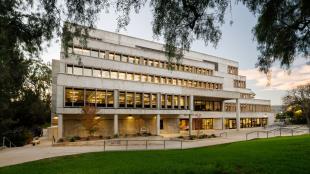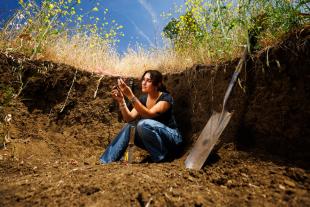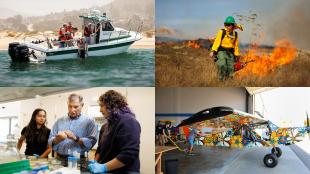'Things Are Changing So Quickly.' Inside Cal Poly's Response to COVID-19
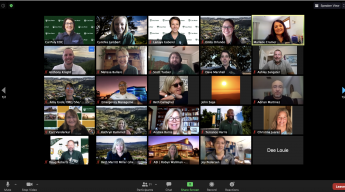
Last December, as a familiar hush fell over campus in the break between fall and winter quarters, Cal Poly’s emergency management office began to stir with activity as the team started tracking an outbreak of a new virus.
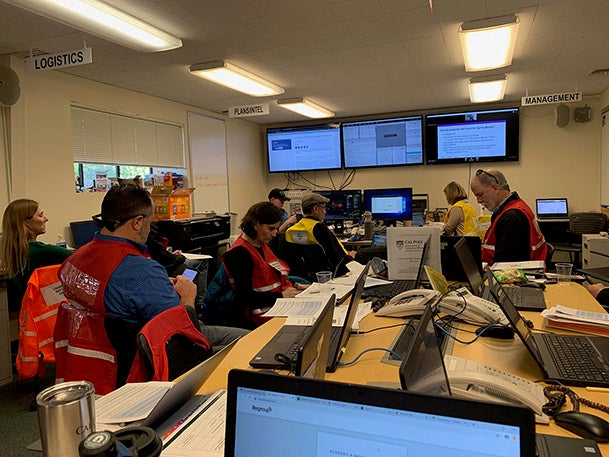
By mid-January, as the university came alive with the bustle of a fresh start of a new quarter, Anthony Knight, director of Cal Poly’s Department of Emergency Management, put the Emergency Operations Center (EOC) on a monitoring status to watch the spread of a new coronavirus, COVID-19 — to track its spread in anticipation of a potential pandemic that could affect the university.
“All emergency managers were thinking the same thing,” Knight said. “It was a conversation of: ‘It’s going to happen — the writing is on the wall.’ It was a question of when.”
For the greater Cal Poly community, that reality would start to settle over campus in early March, when the virus had spread to nearly 70 countries, including the U.S. That’s when Knight fully activated the EOC, bringing together employees from divisions and departments across campus to plan and coordinate the university’s response.
“We have to get the doers and decision makers together in order to rapidly respond to an emergency,” he said.
At its core, an EOC is a collaborative coordination system through which recommendations and frameworks are developed and presented to Cal Poly President Jeffrey D. Armstrong and his cabinet for consideration and approval.
“Every area of campus needs to be involved, because we need to consider all populations and all needs and all circumstances,” said Lanaya Gaberel, director of Employee and Organization Development and one of the EOC’s planning section chiefs.
“The EOC really brings all perspectives together in a really coordinated way,” she added. “One of the silver linings of working in the EOC is being able to connect and getting a broader look at campus and all of the different ways we provide for our students and employees.”
Cal Poly has maintained an EOC for at least 15 years, but the Department of Emergency Management was established when Knight, a U.S. Coast Guard Reserve member who has responded to more than 250 catastrophic incidents over 15 years in emergency management, joined Cal Poly four years ago. Since then the department has added a few positions, including Emergency Services Manager Dave Lee, who came to Cal Poly last October from Tulare County’s Office of Emergency Services.
And Knight has developed and structured the EOC with two official teams of employees — the green team and the gold team — which train annually for a variety of emergencies. During that time the EOC has been activated more than 20 times to provide support to the campus during power outages, fires, the mudslide near Fremont Hall, and other incidents.
None of those previous activations lasted longer than a few days. The COVID-19 activation has lasted more than four months — and counting.
Working in Teams
In the beginning of the outbreak, the EOC team started meeting for chunks of time in its regular location — a nondescript brown building, once a garage for the former university fire station, near the Cal Poly Police Department.
Inside, computers line the walls and sit on a long, center table. Red, yellow, blue and green vests are slung on the backs of chairs, indicating the various sections and positions in the EOC.
The EOC has several key functional areas managing operations, planning, logistics (in charge of obtaining materials and personnel), communications, finance, human resources, and other functions during an emergency.
The branches nestled under the key sections show the breadth of a university campus: academics, student affairs, dining, facilities, agricultural operations, housing, law enforcement, environmental health and safety, medical health and counseling, and information technology.
Tina Hadaway-Mellis, MBA, a registered nurse and assistant vice president for Student Affairs, Campus Health and Wellbeing, was asked early on to serve as operations section chief — essentially overseeing the objectives and tasks for the EOC and ensuring they’re carried out.
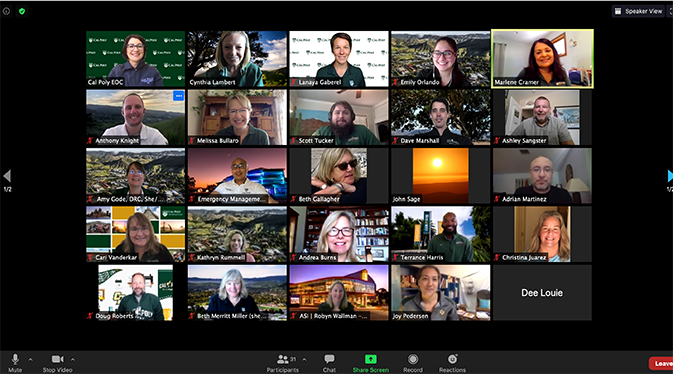
Hadaway-Mellis and Cari Vanderkar, Ph.D., assistant vice provost for international programs, had already started meeting in January, as the virus spread in other countries, to ensure the safety and repatriation of students, faculty and staff studying or working abroad.
“The EOC started to take on more of the all-hands approach,” Hadaway-Mellis said. “We thought that if this is really going to be as big as everyone is predicting, this isn’t just going to be a response by the health center or the EOC’s medical branch. We had to look beyond the traditional EOC structure and fill those holes to include academic operations and the virtual learning environment.”
In all, the EOC team includes about 60 people representing dozens of areas of the university, though not all are called in for every incident. The COVID-19 emergency has taken over the daily routines of about 40 EOC members, many of whom are also trying to balance their EOC responsibilities with their regular, day-to-day jobs.
“It’s very rewarding to be part of this team, but it’s also a lot of work,” said Marlene Cramer, director of Transportation and Parking Services. “We’re all just trying to do our best for the university, and we’ll keep working through this.”
Cramer and Gaberel head up the planning section, which collects and disseminates information on the activities and progress of the EOC team and its task forces — which at one point numbered about 30.
“The EOC involves someone from every area of campus – if they’re not directly on the EOC, they’re on a planning task force and they are involved in the process,” said Emily Orlando, emergency operations analyst for University Housing and the EOC’s deputy operations section chief.
Task forces have been created over the past few months to support the EOC’s goals, working on a wide range of tasks: virtual learning, technology support, isolation and quarantine plans, conducting COVID-19 testing, responding to bias incidents related to COVID-19, supporting international students, determining how employees may return to work, supporting the county’s alternate care site at the ASI Recreation Center on campus, and creating a strategy to clean, disinfect and install signage throughout academic buildings for fall.
On the academic side, six different task forces were created, with nearly 100 people engaged in planning. Those task forces include a provost and deans' group and others focused on virtual teaching and learning, fall planning, study abroad and the International Center, the Office of the Registrar, and study spaces.
Staying Flexible
Soon after the EOC started meeting, the team realized its cozy location would not provide enough space for members to be physically distanced. The team relocated to the much larger Multi-Activity Center inside the Cal Poly Recreation Center.
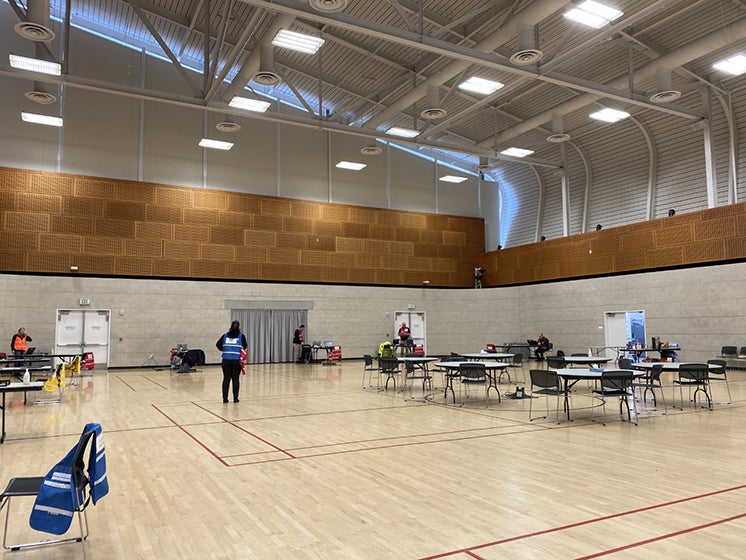
Then, shortly after the first COVID-19 case in San Luis Obispo County in mid-March prompted the university to hold winter quarter finals online, the EOC team also moved to a virtual format, with most members telecommuting and checking in on daily Zoom calls.
Despite the change, the team and its task forces continued to move along at a rapid clip, supporting employees as they transitioned to teleworking, setting up virtual labs and other technology needs to support a virtual spring quarter, helping Campus Health and Wellbeing offer virtual counseling, and creating robust virtual programming and events to engage and support students through a confusing, difficult time.
As the quarter drew to a close, the EOC helped support University Housing’s plans to allow 2,922 students, who had studied at their permanent homes in the spring, back on campus at staggered times to retrieve their belongings from the residence halls.
Over the summer — as 6,512 students participated in virtual courses, compared to an average of 2,000 in past years — the EOC team has also continued its fast pace, with planning focused on fall. Task forces are focused on plans for quarantine and isolation of ill students, testing, and exposure reduction investigations (essentially contact tracing, though that term is specific to public health departments).
Signs are being installed across campus to guide students, faculty and staff as they return for some in-person labs and activities in the fall, and thousands of face coverings, face shields, disposable gloves and sanitizing wipes have been ordered for students, faculty and staff to support health and safety.
“Our work is focused on putting measures in place to provide an opportunity for students to learn in person from the brain trust here at the university,” said Lee, who has been heavily involved in writing a majority of the university’s plans for fall quarter.
The EOC team now has an increased focus on supporting its medical health efforts. But it is not deactivating anytime soon — and it is ready to pivot to respond to whatever happens in fall quarter and beyond.
"Things are changing so quickly that it’s taught a lot of us to be very flexible,” Hadaway-Mellis said. “We may be on one path today and we may have guidance from the state tomorrow that sets us on a similar but different path.”
In addition, she noted, the global research that’s been conducted since January on COVID-19 has helped inform the campus response.
“We are so much farther ahead scientifically from where we were in January,” she said. “From that standpoint we’re so much better educated, we know more about COVID-19 and this is guiding all of our non-pharmaceutical interventions: we know to wash our hands, have face covering mandates and we know that physical distancing — staying 6 feet apart — is what it’s all about.”
If there is a silver lining from the COVID-19 pandemic, it is how well the campus community can come together in an emergency.
“Going in, I knew our team was really strong,” Orlando said. “But as the pandemic has unfolded, it’s really shown us how much we can count on each other and how much we can work together across campus — across academic departments and service-oriented departments and auxiliaries.”
“I hope the coordination and communication throughout campus continues beyond COVID-19.”
Cynthia Lambert, a communications specialist in Cal Poly’s University Communications and Marketing office, also serves as one of the public information officers in the Cal Poly Emergency Operations Center.

